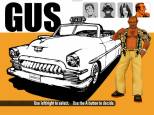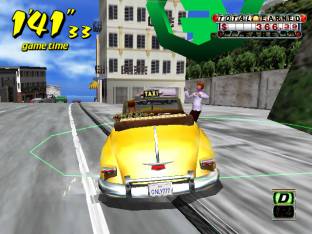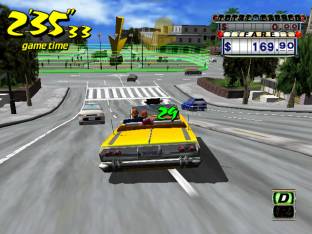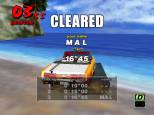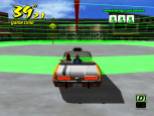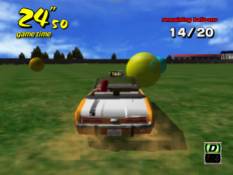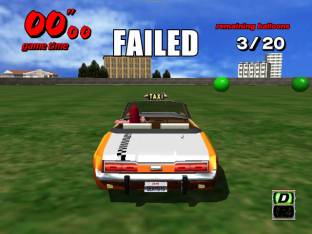The Dreamcast port of the hit arcade game, Crazy Taxi, is arguably even better than its famous parent, because it features two new play modes and a variety of other additions and enhancements. It was developed by Hitmaker and first published for the Dreamcast by Sega in 2000.
In Crazy Taxi you choose between four different drivers (Axel, B.D. Joe, Gena and Gus), each of which has slightly different attributes, and drives a different type of car. The main objective of the game is to pick up customers in your cab and drive them to their destination as quickly as possible.
Once you’ve stopped to allow a customer to jump in, you then follow the large green arrow at the top of the screen to your passenger’s destination. It’s not always best to drive as the crow flies, though, because there are often obstacles in the way, which you must drive around (or through). So it pays to know the environment that you’re driving around in. Once you’ve reached your passenger’s destination you must stop inside a specified area to drop them off. If you made it there quick enough your customer’s fare will be added to your cash total and a rating will be awarded to you, depending on how long it took to complete the journey. Extra money can also be earned by performing stunts, and dodging other cars, on the way.
Crazy Taxi on the Dreamcast features two modes of play: “Arcade” and “Original“, with each providing a different size location to drive around in. In both Arcade and Original modes you can choose between three, five, or ten minute play times, or play by “Arcade Rules” and start with one minute of play time and extend it by completing rides. In Original mode the environment has been greatly expanded, making it possible to become lost if you don’t know your way around.
The Dreamcast version of Crazy Taxi also features “Crazy Box” mode, which is a set of minigames that feature different types of driving challenges, such as time trials, jumps, bowling, and even balloon-popping.
The soundtrack of Crazy Taxi features multiple songs from the bands Bad Religion and The Offspring, which is probably one of the reasons why the game is so memorable, but unfortunately all of the tracks are edited short versions and quickly become repetitive. Adding a few more bands into the mix might have been a good idea, because Crazy Taxi sounds more like a day in the life of a hyperactive teenager than a serious challenger to the famous soundtracks of the Tony Hawk’s Pro Skater series (which, in my opinion, are much more mature, well-rounded and listenable).
Crazy Taxi is also infamous for featuring product placement within the environment, because in addition to generic destinations such as the police station, rail terminal and lookout point, passengers can also request to be taken to Pizza Hut, Tower Records, the FILA store, Levi‘s store, or even KFC. These establishments were replaced with generic businesses in later versions of the game, but are prominent in the Dreamcast version.
Although Crazy Taxi was initially only available for the Dreamcast (for a period of over a year), it was later also released for PlayStation 2, GameCube, Windows, PlayStation 3, XBox 360, iOS, and Android. The Dreamcast version of the game is considered to be a classic on the console and is still fun to play even now. That said: Crazy Taxi is not the best driving game in the world, and probably won’t have long-lasting appeal to anyone over the age of sixteen.
More: Crazy Taxi on Wikipedia








































